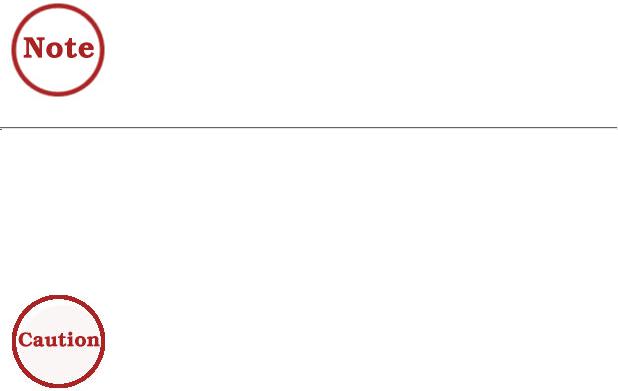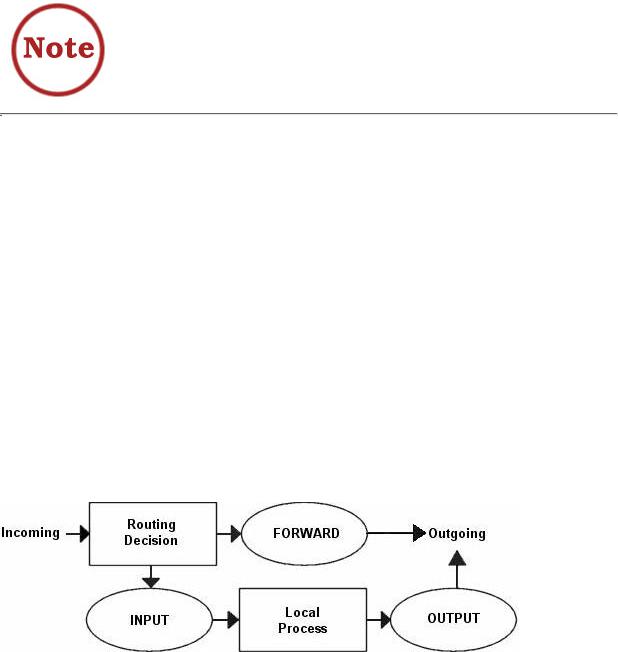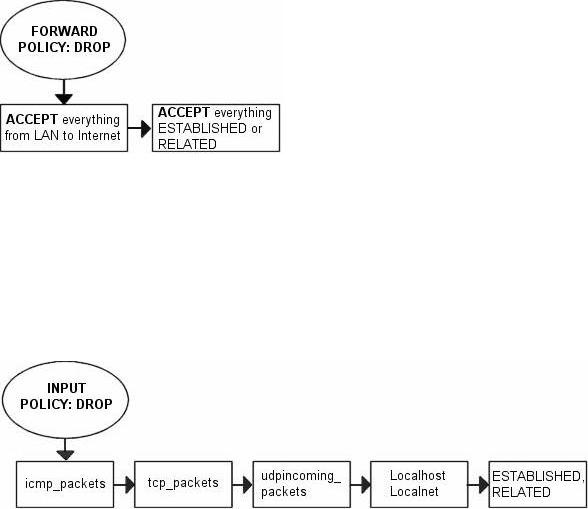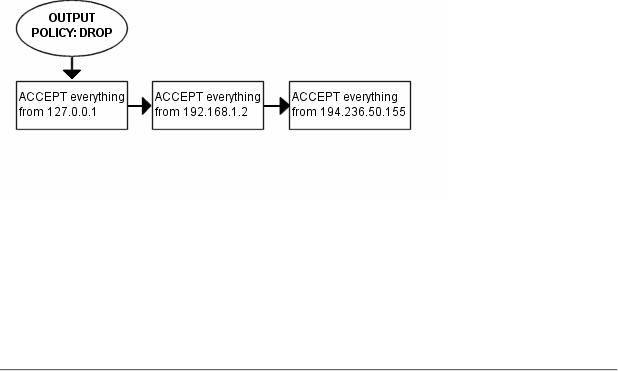
Andreasson O.Iptables tutorial V1.1.9.2001
.pdf
Iptables Tutorial 1.1.9 |
Página 51 |
broken. However, the other way around, it will work flawlessly since the sender will (most probably) give you the correct address to connect to.
As of this writing, there is only the option to load modules which add support for the FTP and IRC protocols. For a long explanation of these conntrack and nat modules, read the Common problems and questionmarksappendix. There are also H.323 conntrack helpers within the patch-o-matic, as well as some other conntrack helpers. To be able to use these helpers, you need to use the patch-o- matic and compile your own kernel. For a better explanation on how this is done, read the
Preparationschapter.
Note that you need to load the ip_nat_irc and ip_nat_ftp if you want Network Adress Translation to work properly on any of the FTP and IRC protocols. You will also need to load the ip_conntrack_irc and ip_conntrack_ftp modules before actually loading the NAT modules. They are used the same way as the conntrack modules, but it will make it possible for the computer to do NAT on these two protocols.
proc set up
At this point we start the IP forwarding by echoing a 1 to /proc/sys/net/ipv4/ ip_forward in this fashion:
echo "1" > /proc/sys/net/ipv4/ip_forward
It may be worth a thought where and when we turn on the IP forwarding. In this script and all others within the tutorial, we turn it on before actually creating any kind of IP filters (ie, iptables rulesets). This will lead to a brief period of time where the firewall will accept forwarding any kind of traffic for everything between a millisecond to a minute depending on what script we are running and on what box. This may give malicious people a small timeframe to actually get through our firewall. In other words, this option should really be turned on after creating all firewall rules, however, I have chosen to turn it on here to maintain consistency with the script breakdown currently user.
In case you need dynamic IP next option, ip_dynaddr
support, for example if you use SLIP, PPP or DHCP you may enable the by doing the following :
echo "1" > /proc/sys/net/ipv4/ip_dynaddr
If there is any other options you might need to turn on you should follow that style, there's other documentations on how to do these things and this is out of the scope of this documentation. There is a good but rather brief document about the proc system available within the kernel, which is also available within the Other resources and links appendix. Also, it may be worth looking at that appendix in the future, in case there are possible additional links added to other and better resources of information.
http://people.unix-fu.org/andreasson/iptables-tutorial/iptables-tutorial.html |
21:25:51 10/06/2002 |

Iptables Tutorial 1.1.9 |
Página 52 |
The rc.firewall.txt script, and all others contained within this tutorial, do contain a small section of non-required proc settings. These may be a good starters to look at, however, do not turn these on before actually knowing what they mean.
Displacement of rules to different chains
This section will briefly describe my choices within the tutorial regarding user specified chains and some choices specific to the rc.firewall.txt script. Some of the paths I have chosen to go here may be wrong from one or another of aspect. I hope to point these aspects and possible problems out to you when and where they occur. Also, this section contains a brief look back to the Traversing of tables and chainschapter. Hopefully, this will remind you a little bit of how the specific tables and chains are traversed in a real live example.
I have displaced all the different user-chains in the fashion I have to save as much CPU as possible but at the same time put the main weight on security and readability. Instead of letting a TCP packet traverse ICMP, UDP and TCP rules, I simply match all TCP packets and then let the TCP packets traverse an user specified chain. This way we do not get too much overhead out of it all. The following picture will try to explain the basics of how an incoming packet traverses netfilter. With these pictures and explanations, I wish to explain and clarify the goals of this script. We will not discuss any specific details yet, but instead further on in the chapter. This is a really trivial picture in comparison to the one in the Traversing of tables and chains chapter where we discussed the whole traversal of chains and tables in depth.
Based upon this picture, let's make clear what our goals are. This whole example script is based upon the assumption that we are looking at a scenario containing one local network, one firewall and an Internet connection connected to the firewall. This example is also based upon the assumption that we have a static IP to the internet (as opposed to DHCP, PPP and SLIP and others). In this case, we also want to allow the firewall to act as a server for certain services on the internet, and we trust our local network fully and hence we will not block any of the traffic from the local network. Also, this script has as a main priority to only allow traffic that we explicitly want to allow. To do this, we want to set default policies within the chains to DROP. This will effectively kill all connections and all packets that we do not explicitly allow inside our network or our firewall.
In the case of this scenario, we would also like to let our local network do connections to the internet. Since the local network is fully trusted, we want to allow all kind of traffic from the local network to the internet. However, the Internet is most definitely not a trusted network and hence we want to block
http://people.unix-fu.org/andreasson/iptables-tutorial/iptables-tutorial.html |
21:25:51 10/06/2002 |

Iptables Tutorial 1.1.9 |
Página 53 |
them from getting to our local network. Based upon these general assumptions, let's look at what we need to do and what we do not need to do.
First of all, we want the local network to be able to connect to the internet, of course. To do this, we will need to NAT all packets since none of the local computers have real IP addresses. All of this is done within the PREROUTING chain, which is created last in this script. This means that we will also have to do some filtering within the FORWARD chain since we will otherwise allow outsiders full access to our local network. We trust our local network to the fullest, and because of that we specifically allow all traffic from our local network to the internet. Since noone on the Internet should be allowed to contact our local network computers, we will want to block all traffic from the Internet to our local network except already established and related connections, which in turn will allow all return traffic from the Internet to our local network.
As for our firewall, we may be a bit low on funds perhaps, or we just want to offer a few services to people on the internet. Therefore, we have decided to allow HTTP, FTP, SSH and IDENTD access to the actual firewall. All of these protocols are available on the actual firewall, and hence it should be allowed through the INPUT chain, and we need to allow the return traffic through the OUTPUT chain. However, we also trust the local network fully, and the loopback device and IP address are also trusted. Because of this, we want to add special rules to allow all traffic from the local network as well as the loopback network interface. Also, we do not want to allow specific packets or packet headers in specific conjunctions, nor do we want to allow some IP ranges to reach the firewall from the Internet. For instance, the 10.0.0.0/8 address range is reserved for local networks and hence we would normally not want to allow packets from such a address range since they would with 90% certainty be spoofed. However, before we implement this, we must note that certain Internet Service Providers actually use these address ranges within their own networks. For a closer discussion of this, read the Common problems and questionmarks chapter.
Since we have an FTP server running on the server, as well as the fact we want to traverse as few rules as possible, we add a rule which lets all established and related traffic through at the top of the INPUT chain. For the same reason, we want to split the rules down into subchains. By doing this, our packets will hopefully only need to traverse as few rules as possible. By traversing less rules, we make the ruleset less timeconsuming for each packet, and reduce redundancy within the network.
http://people.unix-fu.org/andreasson/iptables-tutorial/iptables-tutorial.html |
21:25:51 10/06/2002 |

Iptables Tutorial 1.1.9 |
Página 54 |
In this script, we choose to split the different packets down by their protocol family, for example TCP, UDP or ICMP. All TCP packets traverse a specific chain named tcp_packets, which will contain rules for all TCP ports and protocols that we want to allow. Also, we want to do some extra checking on the TCP packets, so we would like to create one more subchain for all packets that are accepted for using valid port numbers to the firewall. This chain we choose to call the "allowed" chain, and should contain a few extra checks before finally accepting the packet. As for ICMP packets, these will traverse the icmp_packets chain. When we decided on how to create this chain, we could not see any specific needs for extra checks before allowing the ICMP packets through if we agree with the type and code of the ICMP packet, and hence we accept the directly. Finally, we have the UDP packets which needs to be dealt with. These packets, we send to the udp_packets chain which handles all incoming UDP packets. All incoming UDP packets should be sent to this chain, and if they are of an allowed type we should accept them immediately without any further checking.
Since we are running on a relatively small network, this box is also used as a secondary workstation and to give some extra levy for this, we want to allow certain specific protocols to make contact with the firewall itself, such as speak freely and ICQ.
Finally, we have the firewalls OUTPUT chain. Since we actually trust the firewall quite a lot, we allow pretty much all traffic leaving the firewall. We do not do any specific user blocking, nor do we do any blocking of specific protocols. However, we do not want people to use this box to spoof packets leaving the firewall itself, and hence we only want to allow traffic from the IP addresses assigned to the firewall itself. We would most likely implement this by adding rules that ACCEPT all packets leaving the firewall in case they come from one of the IP addresses assigned to the firewall, and if not they will be dropped by the default policy in the OUTPUT chain.
Setting up the different chains used
So, now you got a small picture on how the packet traverses the different chains and how they belong together. You should also have a clear picture of the goals of this script. It is now about time that we take care of setting up all the rules and chains that we wish to create and to use, as well as all of the rulesets within the chains.
First of all, we set all the default policies on the different chains with a quite simple command.
iptables -P <chain name> <policy>
http://people.unix-fu.org/andreasson/iptables-tutorial/iptables-tutorial.html |
21:25:51 10/06/2002 |

Iptables Tutorial 1.1.9 |
Página 55 |
The default policy is used every time the packets don't match a rule in the chain. After this, we create the different special chains that we want to use with the -N command. The new chains are created and set up with no rules inside of them. The chains we will use are icmp_packets, tcp_packets, udpincoming_packets and the allowed chain for tcp_packets. Incoming packets on eth0, of ICMP type, will be redirected to the chain icmp_packets, of TCP type, will be redirected to tcp_packets and incoming packets of UDP type from eth0 go to udpincoming_packets chain.
INPUT chain
The INPUT chain as I've written it uses mostly other chains to do the hard work. This way we don't get too much load from the iptables, and it will work much better on slow machines which might otherwise drop packets at high loads.
We do certain checks for bad packets here. If you want to fully understand this, you need to look at the Appendices regarding state NEW and non-SYN packets getting through other rules. These packets could be allowed under certain circumstances but in 99% of the cases we wouldn't want these packets to get through. Hence, we log them to our logs and then we DROP them.
First of all we match all ICMP packets in the INPUT chain that come on the incoming interface $INET_IFACE, which in my case is eth0, and send those to the icmp_packets, which was previously described. After this, we do the same match for TCP packets on the $INET_IFACE and send those to the tcp_packets chain, and after this all UDP packets get sent to udpincoming_packets chain.
Finally, we check for everything that comes from our $LOCALHOST_IP, which would normally be 127.0.0.1 and ACCEPT all incoming traffic from there, do the same for everything to $LAN_IP, which in my case would be 192.168.0.0/24, and after this, something that some might consider a security problem, I allow everything that comes from my own Internet IP that is either ESTABLISHED or RELATED to some connection. Also, we allow broadcast traffic from our LAN. some applications depend on it such as Samba etc. These applications will not work properly without it.
Before we hit the default policy of the INPUT chain, we log it so we might be able to find out about possible problems and or bugs. Either it might be a packet that we just dont want to allow or it might be someone who's doing something bad to us, or finally it might be a problem in our firewall not allowing traffic that should be allowed. In either case we want to know about it so it can be dealt with. Though, we don't log more than 3 packets per minute as to not getting flooded with crap all over the log files, also we set a prefix to all log entries so we know where it came from.
Everything that hasn't yet been caught will be DROP'ed by the default policy on the INPUT chain. The default policy was set quite some time back, as you might remember.
The TCP allowed chain
If a packet comes in on eth0 and is of TCP type, it travels through the tcp_packets chain, if the connection is against an allowed port, we want to do some final checks on it to see if we actually do
http://people.unix-fu.org/andreasson/iptables-tutorial/iptables-tutorial.html |
21:25:51 10/06/2002 |

Iptables Tutorial 1.1.9 |
Página 56 |
want to allow it or not.
First of all, we create the chain the same way as all the others. After that, we check if the packet is a SYN packet. If it is a SYN packet, it is most likely to be the first packet in a new connection so, of course, we allow this. Then we check if the packet comes from an ESTABLISHED or RELATED connection, if it does, then we, again of course, allow it. An ESTABLISHED connection is a connection that has seen traffic in both directions, and since we've got a SYN packet, and a reply to this SYN packet, the connection then must be in state ESTABLISHED. The last rule in this chain will DROP everything else. In this case this pretty much means everything that hasn't seen traffic in both directions, ie, we didn't reply to the SYN packet, or they are trying to start the connection with a non SYN packet. There is no practical use of not starting a connection with a SYN packet, except to portscan people pretty much. There is no currently available TCP/IP implementation that supports opening a TCP connection with something else than a SYN packet to my knowledge, hence, DROP the crap since it's 99% sure to be a portscan.
The ICMP chain
This is where we decide what ICMP types to allow. If a packet of ICMP type comes in on eth0 on the INPUT chain, we then redirect it to the icmp_packets chain as explained before. Here we check what kind of ICMP types to allow. As it is now, I only allow incoming ICMP Echo Replies, Destination unreachable, Redirect and Time Exceeded.
The reason that I allow these ICMP packets are as follows, Echo Replies is what you get for example when you ping another host, if we don't allow this, we will be unable to ping other hosts.
Destination Unreachable is used if a certain host is unreachable, so for example if we send a HTTP request, and the host is unreachable, the last gateway that was unable to find the route to the host replies with a Destination Unreachable telling us that it was unable to find it. This way we won't have to wait until the browser's timeouts kicks in after some 60 seconds or more.
Time Exceeded, is allowed in the case where we might want to traceroute some host or if a packet gets its Time To Live set to 0, we will get a reply about this. For example, when you traceroute someone, you start out with TTL = 1, and it gets down to 0 at the first hop on the way out, and a Time Exceeded is sent back from the first gateway en route to the host we're trying to traceroute, then TTL = 2 and the second gateway sends Time Exceeded, and so on until we get an actual reply from the host we finally want to get to.
For a complete listing of all ICMP types, see the appendix ICMP types. For more information on ICMP types and their usage, i suggest reading the following documents and reports :
 The Internet Control Message Protocol ICMP
The Internet Control Message Protocol ICMP
 RFC 792 - Internet Control Message Protocol by J. Postel.
RFC 792 - Internet Control Message Protocol by J. Postel.
As a side-note, I might be wrong in blocking some of these ICMP types for you, but in my case, everything works perfectly while blocking all the other ICMP types that I don't allow.
http://people.unix-fu.org/andreasson/iptables-tutorial/iptables-tutorial.html |
21:25:51 10/06/2002 |

Iptables Tutorial 1.1.9 |
Página 57 |
The TCP chain
So now we reach TCP connections. This specifies what ports that are allowed to use on the firewall from the Internet. Though, there is still more checks to do, hence we send each and one of them on to allowed chain, which we described previously.
-A tcp_packets tells iptables in which chain to add the new rule, the rule will be added to the end of the chain. -p TCP tells it to match TCP packets and -s 0/0 matches all source addresses from 0.0.0.0 with netmask 0.0.0.0, in other words all sources addresses, this is actually the default behaviour but I'm using it for brevity in here. --dport 21 means destination port 21, in other words if the packet is destined for port 21 they also match. If all the criteria are matched, then the packet will be targeted for the allowed chain. If it doesn't match any of the rules, they will be passed back to the original chain that sent the packet to the tcp_packets chain.
As it is now, I allow TCP port 21, or FTP control port, which is used to control FTP connections and later on I also allow all RELATED connections, and that way we allow PASSIVE and PORT connections since the ip_conntrack_ftp module is, hopefully, loaded. If we don't want to allow FTP at all, we can unload the ip_conntrack_ftp module and delete the $IPTABLES -A tcp_packets -p TCP -s 0/0 --dport 21 -j allowed line from the rc.firewall.txt file.
Port 22 is SSH, much better than allowing telnet on port 23, if you want to allow anyone from the outside to use a shell on your box at all. Note that you are dealing with a firewall. It is always a bad idea to give others than yourself any kind of access to these kind of boxes. Firewalls should always be kept to a bare minimum and not more.
Port 80 is HTTP, in other words your web server, delete it if you don't want to run a web server on your site.
And finally we allow port 113, which is IDENTD and might be necessary for some protocols like IRC, etc to work properly.
If you feel like adding more open ports with this script, well, its quite self explanatory how to do that by now=).
The UDP chain
If we do get a UDP packet on the INPUT chain, we send them on to udpincoming_packets where we once again do a match for the UDP protocol with -p UDP and then match everything with a source address of 0.0.0.0 and netmask 0.0.0.0, in other words everything again. If they have a source port of 53 also, we ACCEPT them directly.
As it is now, I ACCEPT incoming UDP packets from port 53, which is what we use to do DNS lookups, without this we wouldn't be able to do domain name lookups and we would be reversed to only use IP's. We don't want this behaviour, hence we allow DNS, of course.
I personally also allow port 123, which is NTP or network time protocol. This protocol is used to set your computer clock to the same time as certain other time servers which have very accurate clocks.
http://people.unix-fu.org/andreasson/iptables-tutorial/iptables-tutorial.html |
21:25:51 10/06/2002 |

Iptables Tutorial 1.1.9 |
Página 58 |
Though, most of you probably don't use this protocol, I'm allowing it per default since I know there are some who actually do.
We currently also allow port 2074, which is used for certain real-time `multimedia' applications like speak freely which you can use to talk to other people in real-time by using speakers and a microphone, or even better, a headset.
Port 4000 is the ICQ protocol. This should be an extremely well known protocol that is used by the Mirabilis application named ICQ. There is at least 5 different ICQ clones for Linux and it's one of the most widely used chat programs in the world. I doubt there is any further need to explain what it is.
OUTPUT chain
Since i know that there's pretty much no one but me using this box which is partially used as a Firewall and a workstation currently, I allow pretty much everything that goes out from it that has a source address $LOCALHOST_IP, $LAN_IP or $STATIC_IP. Everything else might be spoofed in some fashion, even though I doubt anyone that I know would do it on my box. Last of all we log everything that gets dropped. If it does get dropped, we'll sure as hell want to know about it for some reason or another. Either it's a nasty error, or it's a weird packet that's spoofed. Finally we DROP the packet in the default policy.
FORWARD chain
Even though I haven't actually set up a certain section in the rc.firewall.txt example file, I would like to comment on the few lines in there anyways. As it is now, we first of all ACCEPT all packets coming from our LAN with the following line:
/usr/local/sbin/iptables -A FORWARD -i $LAN_IFACE -j ACCEPT
So everything from our Localnet's interface gets ACCEPT'ed whatever the circumstances. After this we allow everything in a state ESTABLISHED or RELATED from everywhere, in other words, if we open a connection from our LAN to something on the Internet, we allow the packets coming back from that site that's either ESTABLISHED or RELATED but nothing else. And after this we log everything and drop it. We log maximally 3 log entries per minute as to not flood our own logs, and prefix them with a short line that is possible to grep for in the logfiles. Also we log them with debug level. We finally hit the default policy of the FORWARD chain that says to DROP everything.
PREROUTING chain of the nat table
The PREROUTING chain is pretty much what it says, it does network adress translation on packets before they actually hit the routing tables that sends them onwards to the INPUT or FORWARD chains in the filter table. Note that this chain should not be used for any filtering or such, it should be used for network adress translation, among other things since this chain is only traversed by the first packet in a stream.
http://people.unix-fu.org/andreasson/iptables-tutorial/iptables-tutorial.html |
21:25:51 10/06/2002 |

Iptables Tutorial 1.1.9 |
Página 59 |
First of all we check for obviously spoofed IP addresses, such as in case we get packets from the Internet interface that claim to have a source IP of 192.168.x.x, 10.x.x.x or 172.16.x.x, in such case, we drop them quicker than hell since these IP's are reserved especially for local intranets and definitely shouldn't be used on the Internet. This might be used in the opposite direction, too, if we get an packet from $LAN_IFACE that claims to not come from an IP address in the range which we know that our LAN is on, we might drop that too. As it looks now, we don't do that though.
Starting the Network Address Translation
So, our final mission would be to get the MASQUERADEing up, correct? At least to me. First of all we add a rule to the nat table, in the POSTROUTING chain that will masquerade all packets going out on our interface connected to the Internet. For me this would be eth0. However, there are specific variables added to these example scripts that may be used to automatically configure these settings. These settings are widely used within the example scripts, mainly to make them easier to configure, but also to improve the readability a bit. The -t option tells us which table to use, in this case nat while the - A command tells us that we want to Add a new rule to an existing chain named POSTROUTING and -o $INET_IFACE tells us to match all outgoing packets on INET_IFACE (or eth0, per default settings in this script) and finally we target the packet for MASQUERADE'ing. So all packets that match this rule will be masqueraded to look as it came from your Internet interface. Simple, isn't it?
The next step we take is to ACCEPT all packets traversing the FORWARD chain in the default table filter that come from the input interface eth1 which is my interface connecting to the internal network. All packets that are being forwarded on our box traverse the FORWARD chain in the filter table.
The next thing we do is to ACCEPT all packets from anywhere that are ESTABLISHED and/or RELATED to some connection. In other words, we first send a packet from our local box behind eth1, and since it comes from eth1 we ACCEPT it, then when the Internet box replies, it gets caught by this rule since the connection has seen packets in both directions.
The last thing we do is to log all traffic that gets dropped over the border, and hits the default policy. In some cases these might be packets that should have gotten through but didn't, in other cases it might be packets that definitely shouldn't get through and you want to be notified about this. We allow this rule to be matched a maximum of 3 times per minute with a burst limit of 3. This means we get maximally 3 log entries per minute from this specific line, and the burst is also set to 3 so if we get 3 log entries in 2 seconds, it'll have to wait for another 1 minute for the next log entry. This is good if someone starts to flood you with crap stuff that otherwise would generate many megabytes of logs. We also set a prefix to the log with the --log-prefix and set the log level with the --log-level. Log level tells the syslogd, or logging facility what kind of importance this log entry has.
Example scripts
The objective of this chapter is to give a fairly brief and short explanation of each script available with this tutorial, and to provide an overlook of the scripts and what services they provide. These scripts are not in any way perfect, and they may not fit your exact intentions perfectly. It is in other words up to you to make these scripts suitable for your needs. The rest of this tutorial should most probably be
http://people.unix-fu.org/andreasson/iptables-tutorial/iptables-tutorial.html |
21:25:51 10/06/2002 |

Iptables Tutorial 1.1.9 |
Página 60 |
helpful in making this feat. The first section of this tutorial deals with the actual structure that I have established in each script so we may find our way within the script a bit easier.
rc.firewall.txt script structure
All scripts written for this tutorial has been written after a specific structure. The reason for this is that they should be fairly conformative to each other and to make it easier to find the differences between the scripts. This structure should be fairly well documented in this brief chapter. This chapter should hopefully give a short understanding to why all the scripts has been written as they have, and why I have chosen to maintain this structure.
Even though this is the structure I have chosen, do note that this may not be the best structure for your scripts. It is only a structure that I have chosen to use since it fits the need of being easy to read and follow the best according to my logic.
The structure
This is the structure that all scripts in this tutorial should follow. If they differ in some way it is probably an error on my part, unless it is specifically explained why I have broken this structure.
1.Configuration - First of all we have the configuration options which the rest of the script should use. Configuration options should pretty much always be the first thing in any shell-script.
1.Internet - This is the configuration section which pertains to the Internet connection. This could be skipped if we do not have any Internet connection. Note that there may be more subsections than those listed here, but only such that pertains to our Internet connection.
1.DHCP - If there are possibly any special DHCP requirements with this specific script, we will add the DHCP specific configuration options here.
2.PPPoE - If there are a possibility that the user that wants to use this specific script, and if there are any special circumstances that raises the chances that he is using a PPPoE connection, we will add specific options for those here.
2.LAN - If there is any LAN available behind the firewall, we will add options pertaining to that in this section. This is most likely, hence this section will almost always be available.
3.DMZ - If there is any reason to it, we will add a DMZ zone configuration at this point. Most scripts lacks this section, mainly because any normal home network, or small corporate network, will not have one.
4.Localhost - These options pertain to our localhost. These variables are highly unlikely to change, but we have put most of it into variables anyway. Hopefully, there should be no reason to change these variables.
http://people.unix-fu.org/andreasson/iptables-tutorial/iptables-tutorial.html |
21:25:51 10/06/2002 |
